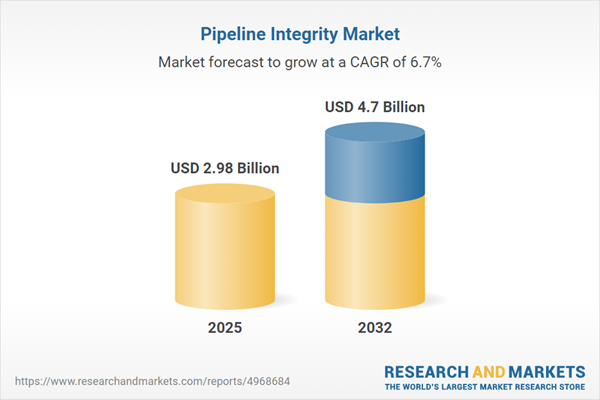Speak directly to the analyst to clarify any post sales queries you may have.
The pipeline integrity market is evolving rapidly as the energy sector faces increased demands for operational efficiency, regulatory compliance, and environmental responsibility. As pipeline networks become more complex and societal scrutiny intensifies, reliability and innovation in maintaining infrastructure integrity now sit at the core of strategic decision-making for industry leaders.
Market Snapshot: Pipeline Integrity Market Overview
The Pipeline Integrity Market grew from USD 2.79 billion in 2024 to USD 2.98 billion in 2025. It is expected to continue growing at a CAGR of 6.70%, reaching USD 4.70 billion by 2032. Rising emphasis on safe resource delivery, aging infrastructure, and increasing adoption of advanced inspection technologies are driving robust market expansion and diversification across key regions.
Scope & Segmentation of the Pipeline Integrity Market
This report provides a comprehensive breakdown of the pipeline integrity market, analyzing its landscape by technique, service, component, material, platform, end user, and region. The research also examines technological developments and leading companies influencing current and future dynamics.
- Techniques: Eddy current testing (conventional and pulsed), magnetic flux leakage (conventional and high resolution), radiographic testing (gamma ray, X-ray), ultrasonic testing (conventional UT, phased array UT), visual inspection (direct and remote).
- Services: Inspection (comprehensive, routine), maintenance (predictive, preventive), monitoring, repair, and testing.
- Components: Fittings; pipelines (distribution, transmission); pumps; tanks; valves (ball, gate).
- Materials: Carbon steel, composite, plastic polymer, stainless steel.
- Platforms: Aerial drones, in-line tools (pig, smart pig), manual tools, robotic systems.
- End Users: Chemical plants, oil & gas companies (IOC, NOC), pipeline operators (national, private), refineries, utilities (power and water).
- Regions: Americas (United States, Canada, Mexico, Brazil, Argentina, Chile, Colombia, Peru), Europe, Middle East & Africa (United Kingdom, Germany, France, Russia, Italy, Spain, Netherlands, Sweden, Poland, Switzerland, United Arab Emirates, Saudi Arabia, Qatar, Turkey, Israel, South Africa, Nigeria, Egypt, Kenya), Asia-Pacific (China, India, Japan, Australia, South Korea, Indonesia, Thailand, Malaysia, Singapore, Taiwan).
- Leading Companies: 3M Company, Aegion Corporation, Dominion Energy, Emerson Electric, General Electric, H&M Shared Services, Intero Integrity Services, Matcor, Schlumberger, Schneider Electric.
Key Takeaways for Pipeline Integrity Market Stakeholders
- Digital transformation, including AI and machine learning, is revolutionizing predictive maintenance, enabling stakeholders to prioritize safety and operational uptime.
- Adoption of advanced non-destructive evaluation tools allows for early detection of potential issues, improving decision-making speed and accuracy across asset lifecycles.
- Regional variations in regulatory oversight and infrastructure maturity necessitate customized strategies for technology deployment and compliance management.
- Collaborations among service providers, materials experts, and technology vendors are enabling more robust, future-ready offerings across the market value chain.
- Workforce upskilling in digital and automation platforms is emerging as a vital lever for organizational resilience in meeting both current and future operational challenges.
Tariff Impact: Navigating U.S. Policy Shifts on Pipeline Integrity Solutions
Recent United States tariffs on steel products and specialized components have increased procurement costs and spurred a shift toward domestic sourcing and more resilient supply chains. Companies are investing in high-quality, durable materials and advanced testing solutions to offset price volatility. This policy landscape is accelerating collaborative efforts to develop tariff-resistant equipment and encouraging strategic supplier partnerships within North America.
Methodology & Data Sources
This report is anchored by an in-depth review of industry publications, regulatory documents, technical standards, and more than twenty expert interviews with engineers, operations managers, and market technology leaders. Supplementary case studies and third-party audits were used for data triangulation, providing validated insights supported by peer-reviewed processes.
Why This Report Matters
- Gain a full understanding of market trends, technological advances, and regulatory influences shaping pipeline integrity.
- Develop informed strategies by leveraging segmented and regional analyses that capture differences in infrastructure, compliance obligations, and investment opportunities.
- Identify partnership and innovation opportunities for staying competitive amid supply chain disruptions and policy shifts.
Conclusion
Senior executives can leverage this research to build robust, agile pipeline integrity programs that address safety, cost, and environmental goals. By aligning operational tactics with evolving technologies and policy shifts, decision-makers can ensure long-term asset performance and stakeholder confidence.
Additional Product Information:
- Purchase of this report includes 1 year online access with quarterly updates.
- This report can be updated on request. Please contact our Customer Experience team using the Ask a Question widget on our website.
Table of Contents
3. Executive Summary
4. Market Overview
7. Cumulative Impact of Artificial Intelligence 2025
List of Figures
Samples

LOADING...
Companies Mentioned
The key companies profiled in this Pipeline Integrity market report include:- 3M Company
- Aegion Corporation
- Dominion Energy, Inc.
- Emerson Electric Co.
- General Electric Company
- H&M Shared Services, Inc.
- Intero Integrity Services B.V.
- Matcor, Inc.
- Schlumberger Limited
- Schneider Electric SE
Table Information
| Report Attribute | Details |
|---|---|
| No. of Pages | 189 |
| Published | October 2025 |
| Forecast Period | 2025 - 2032 |
| Estimated Market Value ( USD | $ 2.98 Billion |
| Forecasted Market Value ( USD | $ 4.7 Billion |
| Compound Annual Growth Rate | 6.7% |
| Regions Covered | Global |
| No. of Companies Mentioned | 11 |









